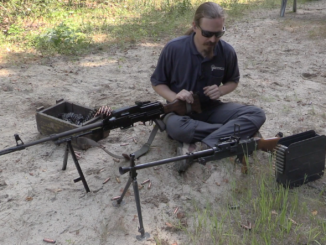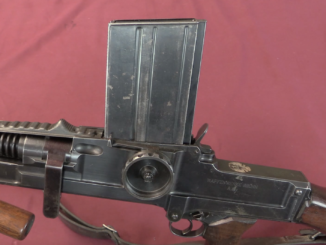The vz.52 pistol was originally adopted by Czechoslovakia as a short-term option, with an intention to quickly replace it with something better. The problem was that without a viable domestic pistol, the Soviet Union would have forced Czechoslovakia to start production of the TT-33 Tokarev. Out of national pride, they did not want to do this – and successfully avoided producing the other standard Soviet bloc small arms as well (like the AK). Well, no alternative was forthcoming for more than 20 years.
In the 1960s, the CZ factory began looking at options for a 9x19mm pistol to export for hard currency, as there was really no Western market for a pistol in 7.62x25mm Tokarev. The project became more serious in 1970 with a real potential for export sales from a Belgian business. At that time, the only option is CZ’s catalog was to simply convert the vz52 to the 9x19mm cartridge, and that was explored. What we have today is one of the factory prototypes of this conversion. It was originally a standard military pistol, retrofitted with a new barrel and ejector, and remarked “vz70” and “9mm PARABELUM” [sic].
Of course, the problems of the vz52 in 7.62mm carried right over to the 9mm version. It had ergonomic problems, reliability problems, and durability problems – and the Belgian business connection was not really excited in trying to market it. Instead, they found a new pistol in development that looked much more promising; the gun that would become the CZ75. But that is a story for a different series of videos…
Thanks to CZ in Uhersky Brod for inviting me to take a look at these and other firearms in their reference library! Make sure to check them out on Facebook and Instagram!




And the lights from above illuminate Gun Jesus.
Ian, it was NOT the Russkies who would force Czechoslovakian Army to adopt Soviet TT – it was the Communized Czechoslovakian military itself who WANTED it badly, and the Soviets were AGAINST it. The Pi-52 was a result of a design process started in 1947, in which a sleek, modern, DA/SA 9 mm Para Strakonice pistol by Kratochvil Bros, called the CZ482 – then later as of 1949 the CZ491 (which was modified as a result of the Swiss trials, in which it almost derailed the Petter P49/P210 pistol!) – was being gradually downgraded and beaten silly into this retrograde 1951 SA ungainly and unwieldy crap called the CZ513, which was soon (April 1952) introduced into the inventory as “7,62 mm Pistole vzor 1952 (Pi-52)”. Further indication to which degree the Soviets were UNWILLING to license the Tokarev, which they themselves regarded long obsolete at that time, is that the Czechoslovak military authorities were finally retorted to have it reverse-engineered, and while this was being done by the Prototypa Praha (viz CZ531), it was then that the Pi-52 was indeed meant as a short-term stop-gap. But not in order to AVOID the Tokarev, but to bridge the gap before it could come into production!
How good a gun could the CZ491 be, is attested to by its ‘small brother’, the Police .32 ACP vzor 50 pistol, which was an almost exact reduced-sized replica of the CZ491, only devoided of the roller-lock, which was absolutely redundant in this small caliber, and with bbl fixed in the frame as a result (this was a folly – HSc and HK4 had .32 bbls contained within the slide and worked just fine).
Ian, as much as I hate Soviets’ influence on Central European small arms design, in Czechoslovakia it was the other way around. In Poland, Rumania, Hungary – wherever the Tokarev was made, there was either no national design of a handgun of any use (Rumania, Hungary) or the industry had to be first reborn to start designing, and the Soviets simply did not have so much time to wait (Poland), so they indeed shoved us the Tokarev down our throat, gave tools to manufacture it and that was that. They DID NOT intended to do this to Czechoslovakia, as Stalin (or whoever from the front row at the Lenin’s Mausoleum bleachers) was purportedly in love with Czech designed weapons and they wanted to see what would Czechs come up with. Of course with intention to grab whatever good ideas were aired, or quench in bud designs that promised to be better. It was the Czechs – or rather Czech-speaking Communists, God-damned traitors with no longer a motherland, installed in power by the Soviets – who imposed the Soviet-weapons reorientation on the Czech industry and military.
In 1945 the Soviets have installed the Czech-Communist government in the first larger Czechoslovakian city they took – Kosice – and had them declared the so-called Kosice Government Program, including a point that in order to secure victory a Soviet-style military would be organized. And they meant ‘Soviet-style literally’, starting with Party Commissars, and including the “small arms that won WW2”.
Then in 1945 the war was won, the Czech military from the West returned, with Cromwell tanks and Spitfires, along with London-based president Benesh and for a while it seemed CSR would stay a democratic island in Central Europe. But the ‘National Unity Govt’ had a significant flaw: the Western-orientated politicians in it had no military muscle, as all the military and internal security apparatus was staffed with the thoroughly Communized Czechs, who still concerned the Kosice Program their ultimate guideline. In February 1948 the Commies staged a coup, took all power, and started Communizing of Czechoslovakia in earnest – with further purges in the military and defense industry. Soviet licenses were deemed the ultimate cure for everything, and admittedly the MiG-15 (Avia S-102) was a better combat jet than the Me-262 Schwalbe (still manufactured in Czechoslovakia postwar as Avia S-92). But in small arms the Soviets were opposed to the replacement of the Czech-designed guns, unless they were unable to convert to Soviet calibers, and so finally only two small-arms licenses were sold and implemented, both machine guns: the 7.62 mm SG-43 and the .50-cal Dushka. And only one of the reverse-engineered weapons was produced, the vz.54 sniper rifle with Mosin-action, leaving Pi-52 a permament solution.
After Stalin’s death new Moscow powers-that-be gave the Czechs licenses for new cartridges (mostly the 7.62×39, as the Czechs shrugged at the 9×18 and stayed with 7.62×25 instead) but other than that, they were told they’re on their own in small arms, as they did not needed technological drips, like the other ComBloc states did. And that made the trick, and not the matters of ‘national pride’, which would only bring Soviet overmatch to bear. BTW, Czechoslovakia was the only ComBloc country to retain a Stalinist regime after the 20th Party Congress and Hungarian Urising of 1956. Actually, they only removed their Stalin Monument in 1961 – the last to do so in the whole of the European ComBloc, save perhaps for Albania.
Thank you for the history lesson. Stuff like this is hard to come by here in the U.S.
“(…)in 1947, in which a sleek, modern, DA/SA 9 mm Para Strakonice pistol by Kratochvil Bros, called the CZ482(…)”
In 1940s also Pistole ČZ 481 was developed
http://www.vhu.cz/pistole-cz-481/
It was chambered for 9×19 mm Parabellum and have magazine capacity 14.
“(…)Czechoslovakia was the only ComBloc country to retain a Stalinist regime after the 20th Party Congress and Hungarian Urising of 1956.(…)”
Wait… so DPRK did not have one in this time?
“(…)Of course with intention to grab whatever good ideas were aired, or quench in bud designs that promised to be better.(…)”
Soviets did trialed Makarov automatic CZ 482 (9×19) against TT (7,62×25) against Makarov (9×18)
https://kalashnikov.media/article/weapons/otchet-strelkovogo-poligona-chekhoslovatskoe-oruzhie-chast-1-pistolety
testers were unimpressed by first, observed that all features did appear in earlier models of fire-arms. Spread proved greater than for TT and for Makarov, it was though due to trigger and sights shape. It proved lot less reliable than Makarov, especially when used with too much grease or without grease or in cold temperature (-45 degrees). Field strip was considered more hard than in case of Makarov. Final conclusion:
уступает самозарядным пистолетам отечественного производства и интереса для оружейной техники не представляет
which might be put simply: inferior [to soviet designs] and not interesting [to us]
Good post. In today’s West, any stick will do to beat Russia as catamite cuckolds fall in line for WW3.
How many different pistols did they produce under the same model number, vz70? I can think of at least one in 7.65 Browning/.32acp
There was no other vz.70 pistol. Ian explained difference between “vz”(vzor/pattern) and CZ(maker) designations. The pistol chambered in 7.65x17mm is designated CZ70; it was used by police force, not by military. It is basically an update of CZ50.
Some of vz.52 pistols made it to Canada and I bought one of them. Also, later I learned about 9mm Para conversion by use of special barrel. I had interest in it but found the 9mm barrels were few and soon disappeared.
Owning this historical pistol is not bad at all. It is kind of oddity, but that makes is more interesting.
Interestingly decades after it withdrawal from Czechoslovak service, new barrel was developed for this weapon, namely .22 Reed Express CZ-52 Barrel
https://shop.reedsammo.com/22-Reed-Express-CZ-52-Barrel-22reedexpcz.htm
As noted vz. 52 was developed from originally 9×19 mm automatic pistol, if you are wondering how last did look like see 1st photo from top here: http://www.vhu.cz/pistole-cz-482/
I love the odd enough a barrel in 38 super would interest me ..
That’s one odd looking prototype, but I can see how it would become CZ75. I myself got a CZ75 Tactical from https://gritrsports.com/shooting/firearms/pistols/9mm-luger/ but in current day it looks almost nothing like this prototype!
So fascinating to see you explain how went from 7.62 to 9×19 step by step. Thanks for a great watch!
The history of the vz.52 pistol is fascinating, especially how it attempted to evolve into a 9x19mm (https://gunsnprices.com/ammo/handgun-ammo/9-19mm-parabellum) variant for export. It’s intriguing to see how national pride influenced Czechoslovakia’s decisions on firearm production during that era.